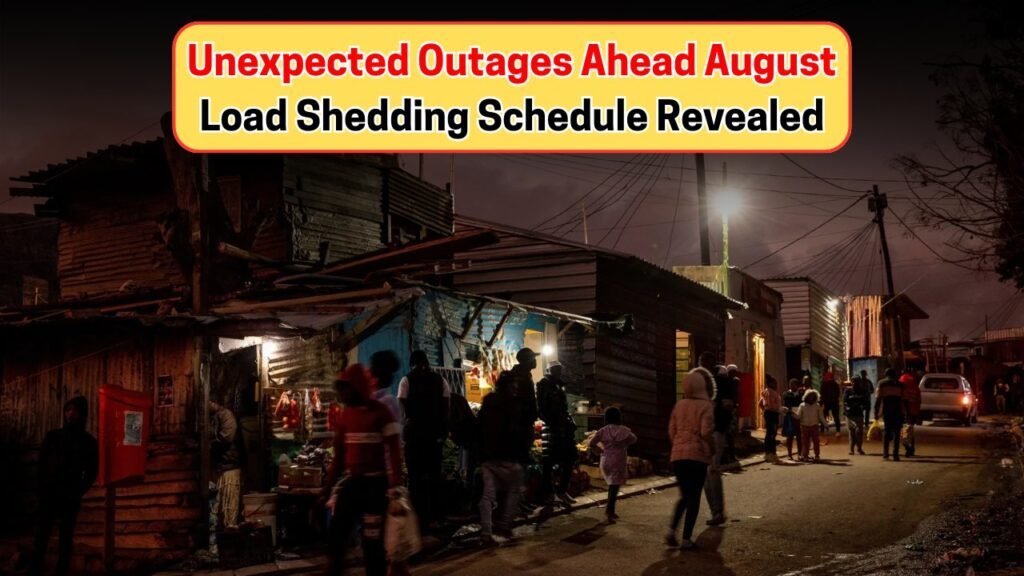Stage 4 Power Cuts in South Africa: As South Africa continues to grapple with ongoing electricity challenges, the announcement of Stage 4 power cuts has drawn significant public attention. These scheduled power outages, also referred to as load shedding, have become a familiar yet frustrating part of daily life for many South Africans. Typically, Eskom, the country’s primary electricity supplier, imposes these power cuts to balance supply and demand, especially during periods of high electricity consumption. For residents and businesses alike, understanding the schedule and preparing for these outages is crucial to mitigate their impact on daily activities and operations.

Understanding the August Schedule for Stage 4 Load Shedding
The announcement of the August schedule for Stage 4 load shedding has prompted many to seek clarity and make necessary preparations. This stage involves more frequent and longer power cuts, affecting both urban and rural areas. Eskom typically releases a schedule that outlines specific times and areas that will be affected, allowing residents to plan accordingly. The utility company’s website and social media platforms are crucial resources for the latest updates and schedules. Understanding the specific time slots helps households manage their energy consumption more effectively, ensuring that essential tasks are completed before power outages occur. While these efforts aim to alleviate some of the stress associated with load shedding, the reality remains that these interruptions can disrupt economic activities, affect productivity, and challenge the resilience of small businesses.
Impact of Stage 4 Load Shedding on South African Businesses
Stage 4 load shedding poses significant challenges for businesses across South Africa. Prolonged power outages can lead to decreased productivity, loss of revenue, and increased operational costs, particularly for sectors heavily reliant on consistent power supply, such as manufacturing, retail, and telecommunications. Small and medium-sized enterprises (SMEs) often bear the brunt, as they may lack the resources to invest in backup power solutions like generators. To mitigate these impacts, many businesses have adopted strategies such as adjusting working hours, investing in alternative energy sources, or implementing energy-saving measures. Despite these adaptations, the uncertainty and unpredictability of load shedding schedules can still hinder business continuity. The economic ripple effects extend beyond immediate financial losses, influencing employment rates and the broader economic landscape.
 South Africa Faces Crisis: 150,000 Students Affected by NSFAS Payment Delays in August 2025
South Africa Faces Crisis: 150,000 Students Affected by NSFAS Payment Delays in August 2025
Adapting to Frequent Power Outages in South Africa
For households and businesses alike, adapting to frequent power outages has become a necessary part of life in South Africa. Residents are increasingly turning to solar power solutions, inverters, and battery storage systems to maintain some level of energy independence during load shedding periods. This shift not only helps reduce reliance on the national grid but also promotes a more sustainable approach to energy consumption. Additionally, community initiatives such as shared power resources and local energy cooperatives are emerging as innovative solutions to address communal energy needs. While these adaptations offer some relief, they also highlight the need for a more robust and sustainable energy infrastructure that can support the country’s growing demand for electricity.
 Discover the August 2025 SASSA Grants: R2,315, R560, and R1,250 Payouts with Full Calendar Details
Discover the August 2025 SASSA Grants: R2,315, R560, and R1,250 Payouts with Full Calendar Details
Future Outlook: Addressing South Africa’s Energy Crisis
The ongoing energy crisis in South Africa necessitates a comprehensive approach to finding long-term solutions. The government, alongside Eskom and other stakeholders, is exploring various strategies to enhance the country’s energy capacity and stability. Investments in renewable energy projects, such as wind and solar farms, are being prioritized to diversify the energy mix and reduce dependency on coal-fired power stations. Moreover, policy reforms aimed at improving energy efficiency and fostering private sector participation in the energy sector are underway. Collaborative efforts between the public and private sectors are essential to drive innovation and investment in sustainable energy solutions. While these initiatives are promising, their success will largely depend on effective implementation, regulatory support, and a commitment to addressing the underlying issues within the energy sector.

